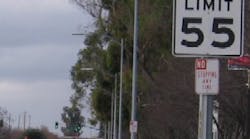“When you hear the thunder, it‘s too late to build the Ark.” -Peter Kissinger, president and CEO, AAA Foundation for Traffic Safety
A lot is changing out on the highways today - some good and some bad. We all know rising fuel prices are rapidly slashing the amount of miles four-wheelers log every day, with commuters scurrying for mass transit and vacationers becoming “staycationers.” Ways to restore our woefully maintained roadway infrastructure are also being hotly debated, from raising fuel taxes sales taxes and adding more tolls to the outright leasing of our roads to private companies - some not even based in the U.S.
But there are other significant changes we must start addressing, too. One theme I‘ve been harping on is a return to a national 55 mph speed limit for cars, light trucks, and commercial trucks - both to reduce the nation‘s consumption of fuel and vehicle crashes.
(No longer the right speed, apparently.)
Now, though, I‘m learning that 55 mph isn‘t the best speed anymore for fuel savings - and may not be the best way to reduce vehicle crashes, either. Conversations with several trucking experts made me finally realize that engineers are designing heavy trucks to get the best fuel economy between 60 and 65 mph now - tuning the engines, transmissions, and aerodynamics of the tractors to that speed range. The same thing is occurring for cars and light trucks, too, so suddenly a return to 55 mph might not generate big fuel savings after all.
Then, according to the Portland, OR-based group Best Highway Safety Practices Institute, 55 mph might not be the best solution for reducing vehicle crashes and pollution or improving fuel savings, either. They feel the solution is to properly engineer roadways for optimum flow of traffic, something that would reduce our total vehicular carbon footprint and improve roadway safety. Their civil engineering solutions include the following:
* Local streets and parking lots are where the majority of our fuel consumption, pollution and accidents occur, so the focus needs to be here.
* Reducing time spent idling, stopping, starting, changing speed, hazards, flow conflicts, cross traffic movements while adopting stronger user and access management plans.
* Using traffic circles can reduce accidents by more than 70%, fatalities by more than 90%, and fuel consumption, pollution, travel times and overall roadway speeds.
* Promoting better driving habits, such as taking the time to rest if you‘re tired and yielding the right-of-way, etc. - efforts that improves the flow of traffic.
Then there‘s another sure-to-be hot button topic - the aging driver population. The AAA Foundation for Traffic Safety recently released what‘s sure to become a highly controversial report noting that by 2025, people aged 65 and older will account for 25% of U.S. drivers, yet that state licensing systems and mobility alternatives for older drivers for the most part are inadequate and inconsistent.
The AAA Foundation report added that senior citizens and their families face serious challenges in maintaining mobility, including determining whether they remain capable of safely operating a motor vehicle, whether their driving can be improved, or -- if unable to drive safely -- how they can continue to be mobile.
“Nobody should have their car keys taken away simply because they reach a certain age,” stressed Peter Kissinger, president and CEO of the AAA Foundation. “Instead, states should screen all drivers applying for new or renewed licenses to ensure they are medically and functionally fit to drive through procedures like eye exams and in-person renewal - but that is not happening. If remedies aren‘t put in place today, we can expect a significant rise in highway safety deaths in the years ahead. That should concern all of us, young and old alike.”
(Oh ho, I can already see the cage match brewing between AAA and AARP - the American Association of Retired People - over THAT bon mot!)
The report also notes a significant lack of comprehensiveness and consistency in medical advisory boards (MABs). Fourteen states lack any type of MAB. As such, AAA is now recommending that all states establish and fund active MABs to conduct individual case reviews and provide input to policy development. Beyond the creation of MABs, state licensing policies and practices should put into place standard reporting laws that provide civil immunity for clinicians, law enforcement, and licensing personnel who report people they believe may be medically unfit to drive.
“It‘s unfortunate that healthcare professionals who believe a patient may be medically unfit to drive in a safe manner do not relay this information to their state DMV to spur further screening,” said Kissinger. “Doctors are well positioned to ensure their patients are fit to drive safely, yet they are fearful of being sued or losing patients if they take actions to protect others on the road - that has to change.”
“One of the fundamental roles of the DMV is to ensure drivers are capable of driving safely, and to restrict, suspend or revoke licenses when drivers demonstrate that they are incapable of driving safely,” says Neil D. Schuster, president and CEO of the American Association of Motor Vehicle Administrators (AAMVA). “But our charge is also to help people transition to alternative forms of transportation when driving is no longer a safe option. And AAMVA is placing renewed emphasis on these issues.”
“AAA is committed to making sure that mature drivers are able to continue driving as long as safely possible and remain mobile thereafter,” said Kathleen Marvaso, AAA‘s national vice president of public affairs - someone who‘s going to be doing a lot of careful explaining in the months ahead about this report‘s conclusions.
(Click here to watch a video produced by the Metropolitan Transportation Commission (MTC) -- the transportation planning, coordinating and financing agency for the nine-county San Francisco Bay Area -- that addresses the issue of older drivers.)
Still, this issue is going to resonate across the trucking community, too, as the truck driver population is rapidly graying. I‘m a firm believer that older drivers are safer drivers myself and that we need to make sure we tap into their valuable experience gained from decades on the road to educate and season younger drivers.
It‘s a very touchy subject, no doubt, but one that needs to be addressed for it‘s certainly going to permanently change the driving landscape for truckers and four wheelers alike in the coming years.



